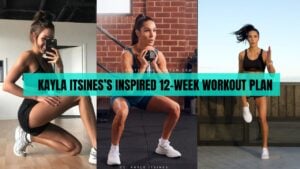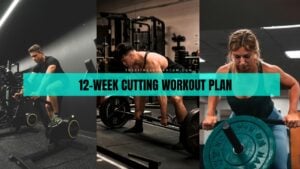High-intensity interval training (HIIT) and Intermittent fasting are both crucial for a healthy lifestyle. They help enhance cardiovascular health, maintain shape, and improve quality of life.
In this article, I’ll share various pros and cons of combining interval training with intermittent fasting. This guide will help you decide whether you should do HIIT while fasting or not.
I’ve also shared a weekly workout routine you can do during intermittent fasting.
Related: The Best Intermittent Fasting Books
What is High-Intensity Interval Training (HIIT)?

High-intensity Interval Training (HIIT) is a workout program that involves performing exercises in intervals, for example – doing exercises at a quick pace for a certain time followed by a short recovery period.
Let’s take an example of 10 minutes running HIIT.
- 2-minute Jog
- 2-minute Run
- 2-minute Jog
- 2-minute Run
- 1.5-minute Jog
- 30-seconds Sprint
Benefits of HIIT
- HIIT burns more calories than traditional cardio and weight training.
- It has the “after-burn effect”. It means your body uses fats and burns calories even after the workout.
- Bodyweight HIIT improves bone density and strengthens skeletal muscles.
- Interval training enhances VO2peak (the maximum rate at which your body uses oxygen during work).1 Ito S. High-intensity interval training for health benefits and care of cardiac diseases – The key to an efficient exercise protocol. World J Cardiol. 2019;11(7):171-188
- High-intensity training helps improve aerobic and anaerobic fitness.
- Intense burst interval training also enhances respiratory function, improves blood pressure, and maintains insulin levels.
- HIIT is also beneficial for mental health. Doing HIIT on a regular basis keeps your mind active and cultivates new ideas.
You can explore more about the pros and cons of high-intensity interval training.
What is Intermittent Fasting?
Intermittent fasting (IF) is a time-restricted fasting pattern that involves fasting for a selected period, followed by an eating window.
Suppose you have decided to follow the 14:10 fasting pattern. It means you’ll have to keep fast for 14 hours straight and consume the foods for the rest of the 10-hour window.
You can complete this fasting schedule according to your lifestyle. For example, if you’re a 9 to 5 person, you can have your last meal at 6, and your next will be at 8 in the morning.
You can select the pattern of fasting depending on your lifestyle. There’s no fixed timing; you can do it when it suits you best.
To get the best result, follow a calorie-restricted diet.
You can stay under calorie deficit by consuming low-calorie foods that contain good protein and fill you up for longer.
Benefits of Intermittent Fasting
Window-eating (IF) has various health benefits, from weight loss to better heart health.
Let’s look at some of the significant pros backed up by science.
- Intermittent fasting improves certain health conditions, such as cardiovascular disease, obesity, diabetes, and neurological disorders.2 De Cabo R and Mattson MP. Effects of intermittent fasting on health, aging, and disease. New England Journal of Medicine. 2019;381(26):2541-2551. DOI: 10.1056/NEJMra1905136
- Restricted eating often results in decreased calorie consumption. And because of this, your body uses stored fat for energy that ultimately helps you lose weight.3 Welton, Stephanie et al. “Intermittent fasting and weight loss: Systematic review.” Canadian family physician Medecin de famille canadien vol. 66,2 (2020): 117-125 (PubMed)
- Research also suggests that IF is an effective way to lower blood glucose and treat type 2 diabetes.4 Albosta M, Bakke J. Intermittent fasting: is there a role in the treatment of diabetes? A review of the literature and guide for primary care physicians. Clin Diabetes Endocrinol. 2021 Feb 3;7(1):3
Pros of Doing HIIT and Intermittent Fasting Together
- Doing HIIT exercises during Intermittent fasting lowers body fat and improves jumping performance in active adult women (21-33 years of age).5Martínez-Rodríguez A, Rubio-Arias JA, García-De Frutos JM, Vicente-Martínez M, Gunnarsson TP. Effect of High-Intensity Interval Training and Intermittent Fasting on Body Composition and Physical Performance in Active Women. Int J Environ Res Public Health. 2021 Jun 14 (PubMed)
- Fasting, with or without HIIT, can be an effective way to prevent weight gain.
- Restricted eating and interval training also reduce insulin levels and seem to be an important time-efficient strategy for treating type 2 diabetes.
- Combining Intermittent fasting and HIIT lowers body fats, increases fat-free mass, and improves body composition.6 Batitucci, Gabriela et al. “Impact of Intermittent Fasting Combined With High-Intensity Interval Training on Body Composition, Metabolic Biomarkers, and Physical Fitness in Women With Obesity.” Frontiers in nutrition vol. 9 884305. 26 May. 2022, doi:10.3389/fnut.2022.884305
Disadvantages of Doing HIIT Exercise During Intermittent Fasting
Intermittent fasting and HIIT together don’t always work the best for everyone. It also has some downsides, which you may know.
- Fasteed HIIT can cause dizziness, fatigue, low blood pressure, and abnormal heart rate.
- Sometimes, post-fasting can reverse the effect of weight loss. Because after a fasting period, people tend to eat heavy foods that contain high calories. Extreme hunger may lead you to consume more calories than you eat without fasting. As a result, you eat more calories than your body needs.
- Some research has also shown that fasting in the long term may slow down your metabolism.
- When you’re in the fasted state, you’ll have less energy. And because of this, you won’t be able to work out as hard as you do in the fed state.
Can You Do HIIT During Intermittent Fasting?
Yes, you can do it. However, doing HIIT before, during, or after fasting depends on your fitness level.
Working out in the fed state allows you to do exercises at a higher intensity and for a longer duration.
Working out during the fasting window helps you burn more fat because your body will use stored fat for energy.
Exercising before fast will also be ideal for those who want to work out and fast separately and focus on one thing at a time.
Traning post-fasting is ideal for those who haven’t had the opportunity to exercise during or before the fasting mode. It will also fit those who want to capitalize on fasting diets.
You can do it whenever suits you the most. Moreover, you can also alternate your workout schedule between the fed and fasting state.
For example, you can work out in the eating window on your first day of fasting. While on the second day, you can do HIIT during the fasting window.
Please consider the tips below for better results.
- Always listen to your body; don’t pressurize it.
- Try all three of them for a certain period of time, then do what suits you the best.
- Keep yourself hydrated whenever you do exercises.
The HIIT Workout Routine You Can Do While Fasting
- Duration: 15-20 minutes
- Workout Time: Anytime During the Fast
- Difficulty Level: Intermediate
- Target Gender: All
- Sessions per week: Three
- Suggested Duration: 6-8 weeks
- Workout Goal: Weight Loss and Improve Shape
Monday
- Jumping Jacks: 10 reps, 30-sec rest
- Kneeling Pushups: 20 reps, 30-sec rest
- High Knes: 30-sec, 45-sec rest
- Mountain Climber: 10 reps, 30-sec rest
- Squats: 10-20 reps, 30-sec rest
- Reverse Crunches: 15-20 reps, 30-sec rest
- Shoulder Taps: 10 taps per side, 30-sec rest
- Jumping Lunges: 5 reps on each side, 30-sec rest
- Front Plank: As long as you can hold.
- Repeat as many times as possible in 20 minutes.
Wednesday
- High Knees: 15-sec, 30-sec rest
- Alternating Heel Taps: 10 taps on each side, 30-sec rest
- Kneeling Push-ups: 10-12 reps, 30-sec rest
- Flutter Kicks:15-sec, 30-sec rest
- Shadow Punches: 30-sec, 30-sec rest
- Crossbody Mountain Climbing: 15-sec, 30-sec rest
- Squat Jumps: 10 reps, 30-sec rest.
- Side Plank: 15-sec hold per side, 15-sec rest
- Repeat until 20 minutes
Friday
- Ankle Hops: 15-sec, 30-sec rest
- Half Burpees: 10 reps, 30-sec rest
- Plank Jacks: 10 reps, 30-sec rest
- Shoulder Taps: 10 taps per side, 30-sec rest
- Kneeling Pushups: 10-12 reps, 30-sec rest
- Squat Jumps: 10 reps, 30-sec rest
- Spider Mountain Climber: 15-sec, 30-sec rest
- Scissor Kicks: 15-sec, 30-sec rest
- Front Plank: As long as you can hold.
- Repeat until 20 minutes.
Additional Exercises:
Workout Tips
- You can take pre-workout drinks or snacks to help you perform well during the exercises.
- Whether you’re in the fasting state or in the normal state, keep yourself hydrated during the workout.
- Avoid strength training while you’re fasting because strength training requires more carbohydrates.
Note: If you’re not overweight, there’s no reason to work out while fasting.
Who Should Not Do Intermittent Fasting and HIIT?
Intermittent fasting and HIIT ain’t for everyone. It requires exercise experience and knowledge combining exercise and fasting.
Here’s a list of people who should avoid HIIT and fasting.
- If you want to increase your weight and gain muscles simultaneously.
- Pregnant or on breast-feeding.
- an undernourished person.
- If you have an eating disorder or suffering from Prader-Willi.
Final Words
HIIT and intermittent fasting suit those trying to lose excess body fat.
Studies also demonstrated that restricted eating is an effective strategy for treating overweight and obesity.7 Welton S, Minty R, O’Driscoll T, Willms H, Poirier D, Madden S, Kelly L. Intermittent fasting and weight loss: Systematic review. Can Fam Physician. 2020 Feb;66(2):117-125
Interval training also has a positive impact on fat loss.8 Boutcher SH. High-intensity intermittent exercise and fat loss. J Obes. 2011;2011:868305. Epub 2010 Nov 24
They also lower the risk of cardiovascular diseases, decrease blood sugars, improve lipid profile, and treat type II diabetes without medication.
Combining HIIT and intermittent fasting has both pros and cons. So, I suggest consulting a doctor before starting them.
Related Articles
References
- 1Ito S. High-intensity interval training for health benefits and care of cardiac diseases – The key to an efficient exercise protocol. World J Cardiol. 2019;11(7):171-188
- 2De Cabo R and Mattson MP. Effects of intermittent fasting on health, aging, and disease. New England Journal of Medicine. 2019;381(26):2541-2551. DOI: 10.1056/NEJMra1905136
- 3Welton, Stephanie et al. “Intermittent fasting and weight loss: Systematic review.” Canadian family physician Medecin de famille canadien vol. 66,2 (2020): 117-125 (PubMed)
- 4Albosta M, Bakke J. Intermittent fasting: is there a role in the treatment of diabetes? A review of the literature and guide for primary care physicians. Clin Diabetes Endocrinol. 2021 Feb 3;7(1):3
- 5Martínez-Rodríguez A, Rubio-Arias JA, García-De Frutos JM, Vicente-Martínez M, Gunnarsson TP. Effect of High-Intensity Interval Training and Intermittent Fasting on Body Composition and Physical Performance in Active Women. Int J Environ Res Public Health. 2021 Jun 14 (PubMed)
- 6Batitucci, Gabriela et al. “Impact of Intermittent Fasting Combined With High-Intensity Interval Training on Body Composition, Metabolic Biomarkers, and Physical Fitness in Women With Obesity.” Frontiers in nutrition vol. 9 884305. 26 May. 2022, doi:10.3389/fnut.2022.884305
- 7Welton S, Minty R, O’Driscoll T, Willms H, Poirier D, Madden S, Kelly L. Intermittent fasting and weight loss: Systematic review. Can Fam Physician. 2020 Feb;66(2):117-125
- 8Boutcher SH. High-intensity intermittent exercise and fat loss. J Obes. 2011;2011:868305. Epub 2010 Nov 24












